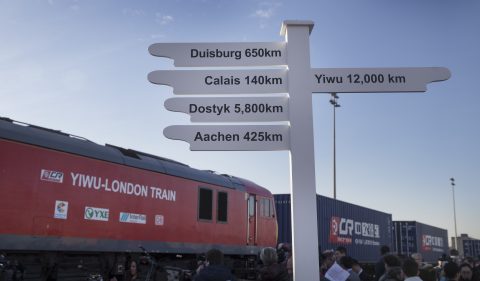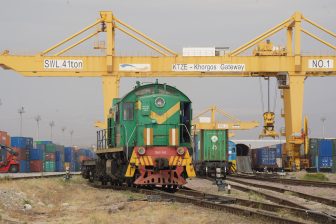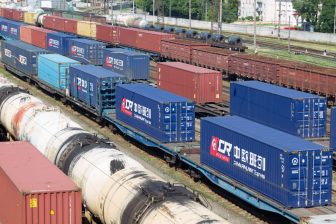
How successful is the New Silk Road really?
The New Silk Road is not always the best option. The Silk Road is not the only route. And the numbers are impressive, but not the only numbers. These are some of the insights Onno de Jong will be sharing at the Silk Road Poland Gateway Summit on March 20-21. As a consultant working at Ecorys, he understands perfectly the dynamics of the railway infrastructure connecting Europa and China. “It is not just solving a logistical puzzle. The whole New Silk Road is part of a reshuffle of the economic order of Europe, Central Asia and the Far East. That comes with opportunities and risks, and we want to share this story with the audience”, he said.
“The overarching project is now called the Belt and Road Initiative. What we see as the focal topic of the conference, the New Silk Road railway connection, is only a small part of it. My co-speaker Wouter Jacobs and I really want to show the different dimensions of the whole Belt and Road Initiative”, de Jong starts off.
Belt and Road Initiative
“The Chinese central government sees the project as driver for future economic growth in China and in the countries China trades with. Also it shapes the position China wants to have in the world of tomorrow. China has become a much more outward looking state with challenges that come from the huge economic development of the last decades. The economic success of China has led to the accumulation of capital in the country and a government willing to provide funds for development of all the BRI projects. This explains the vast amounts of money being available to finance projects.”
At the moment, nobody knows for how long the subsidies will remain in place. “From what I have heard, the subsidies for many destinations will remain in place for the foreseeable future, as politics and logistics are mixed”, de Jong said. “Especially regional governments tend to subsidise connections, also because of the importance placed on the whole project.”
The numbers
In the media the success of the New Silk Road is described with impressive numbers. However, the numbers do not always add up, raising the question how we should interpret the assumed success. De Jong explained: “The growth figures are percentagewise very breathtaking, but one must be aware that compared with airfreight and ocean freight, the volumes are still relatively small.
“As unfortunately more often with transport statistics; different sources tend to state different numbers. Most recent estimates are that volumes on the route amounted to around 350.000 TEU last year. The Eurasian Rail Alliance stated that 175.000 TEU to/from China were transported over the rail networks of Kazakhstan, Russia and Belarus last year. This would imply only a 50 per cent market share for the northern route.”
The discrepancy in numbers makes it challenging to estimate the capacity of the network in several years from now. The northern route, according to multimodal transporter KTZ-Express, should be able to handle as much as 1.7 million TEU in 2020. China Ocean Shipping Company (COSCO) stated the ambition to handle 500.000 TEU in Khorgos in 2020, explained de Jong, relying on most recent statements.
Competitors
Although rail still represents the smallest market share in the transport of freight, it is increasingly becoming an attractive option, more so as rail freight is encouraged by governments in Europe and China. “The threat to air cargo is bigger than the impact on maritime transport”, said de Jong. Moreover, rail does not always pose the best available option. “It depends on the time/value proposition of goods whether land based (rail) transport is a viable alternative.
“HP was one of the pioneers for rail transport from China to Europe in 2012. Here economics made sense. Production of laptops had moved to inland China and the destination of the goods was an inland location in Europe. Also, there was a constant flow of products and enough volume for a full train at a reasonable frequency. The product is not expensive or time-sensitive enough for air cargo so here the train turned out to be a logistical winner.
“Goods that are low in value (or better said, the value density is too low) and not time sensitive are often better brought in via ocean freight. I always use Christmas decoration as an example. One exactly knows when it is Christmas so planning of production and transport can really be done in advance. Most Christmas decoration, at least the type I have, is not really expensive so using rail does not make sense.”
Markets to win
Apart from a contiuously expanding rail network, there are still markets to win for the rail freight sector, de Jong explained. “A possible segment for transport to China might be agricultural products. One of the problems at the moment, and here we enter geopolitics, are the trade bans between the EU and Russia. This limits export possibilities. Also shipping ecommerce between, to and from countries on rail might be an interesting opportunity to develop further in the future.
“We still see an imbalance between westbound and eastbound movement, with trains that go full to the west. The imbalance is apparently shrinking with new cargo segments being brought in towards the east”, he continued. Furthermore, multimodal options are currently being explored. “We have heard about for instance sea-rail concepts between inland China and the US Eastcoast. For project cargo this seems interesting but for consumer products one would have to see if it makes sense to use this option instead of using ports on the US Westcoast or sailing through the Panama Canal.”
Background
Ecorys monitors the railway and advices governments, financial institutions and industry players. For the Dutch Ministry of Foreign Affairs, the consultancy company wrote a report on the phenomenon. Onno de Jong works as Consultant Transport, Infrastructure and Mobility. His main focus areas are seaports, rail transport and topics related to governance, infrastructure and regional economic development. Previously, he worked at the Erasmus University, where he wrote an article on the implications of the New Silk Road on ports in Northwest Europe. This article was presented at the first Nieuwsblad Transport event on the New Silk Road in June last year.






